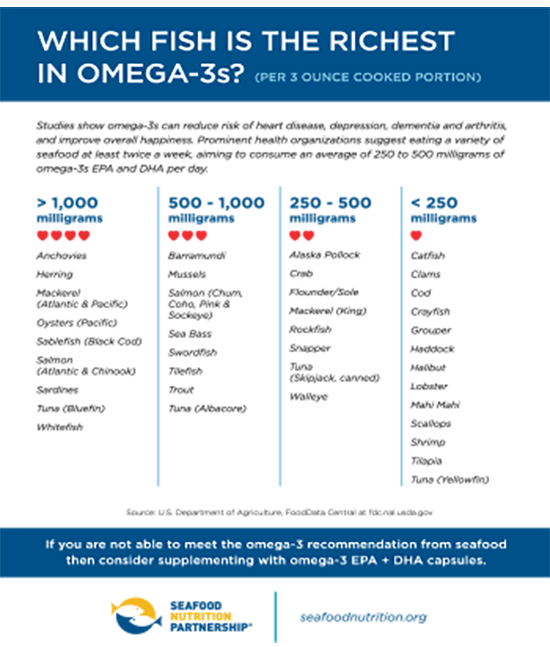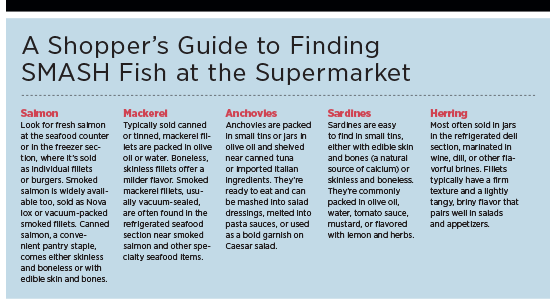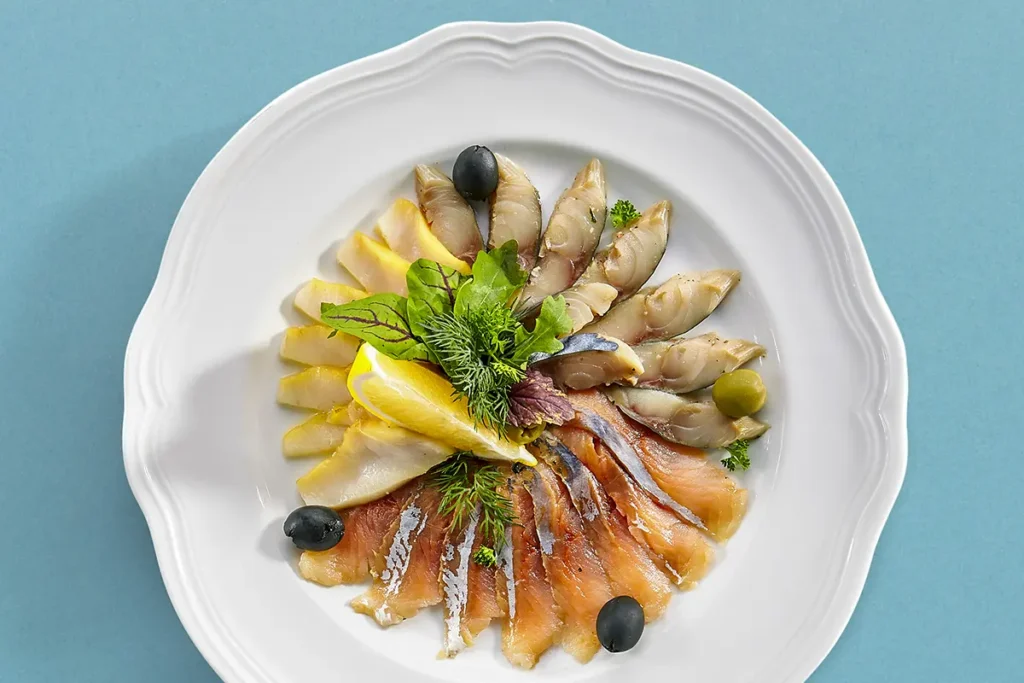Today’s Dietitian
Vol. 27 No. 6 P. 18
Omega-3 fatty acids are essential for health across the lifespan, yet many Americans fall short of current intake recommendations. These polyunsaturated fats come in three main forms: alpha-linolenic acid (ALA), EPA, and DHA. While ALA—found in plant foods like flaxseeds, walnuts, and chia seeds—is beneficial, the body converts only a small fraction into EPA, and even less into DHA.1 That’s why consuming EPA and DHA, found primarily in seafood, is critical for meeting physiological needs.
The health benefits of EPA and DHA are extensive and well documented. Cardiovascular benefits include reduced triglycerides,2 improved blood vessel function,3 lower blood pressure,4 and reduced risk of heart attack.5 DHA is also required for fetal brain and retinal development, and emerging research continues to explore omega-3s in the context of mood disorders such as depression,6 ADHD,7 and even traumatic brain injury.8
Despite these benefits, most Americans consume far too little. The 2015–2020 Dietary Guidelines for Americans recommended consuming 8 oz of seafood per week, which provides an average of 250 mg per day of EPA and DHA. That specific reference to omega-3 intake was omitted in the 2020–2025 guidelines, though they continue to emphasize seafood as part of a healthy dietary pattern. International organizations like the Global Organization for EPA and DHA and the International Society for the Study of Fatty Acids and Lipids suggest even more—at least 500 mg per day. Yet actual estimated current intakes are only around 100 mg for men and 90 mg for women.9
This gap in intake is where SMASH fish—an acronym to represent salmon, mackerel, anchovies, sardines, and herring—can make a measurable difference. These cold-water, oily fish provide a concentrated source of EPA and DHA. According to USDA FoodData Central, a 100-g (3.5 oz) portion of SMASH fish delivers anywhere from 1,000 to 2,300 mg of omega-3s, depending on species, processing, and origin. In contrast, a similar portion of cod provides just 100 mg.
Still, many clients hesitate to embrace these nutritional superstars. The perceived “fishy” flavor, the presence of skin and bones in some canned versions, or unfamiliar formats like jars of pickled herring can be off-putting. Dietitians can play a key role in reducing those barriers—offering reassurance, culinary tips, and approachable recipes that reframe these fish in a new, more delicious light.
A simple weekly habit—two servings of SMASH fish—can go a long way toward closing the omega-3 gap. Beyond the recipes that follow, RDs might suggest folding mashed sardines into hummus, stirring chopped anchovies into a lentil or minestrone soup for a savory kick, or flaking smoked mackerel into grain bowls. With a little creativity, SMASH fish can become a practical, flavorful solution for people of all ages.
— Liz Weiss, MS, RDN, is the mom of two grown boys with a specialty in family nutrition
and healthy aging. She shares recipes and healthful living advice on LizsHealthyTable.
com and her podcast, EAT, DRINK, LIVE LONGER. Weiss is a cooking instructor,
speaker, and frequent lifestyle guest on TV shows across the country.


SMASH RECIPES
These five recipes are designed to make SMASH fish more accessible and appealing to a wide range of eaters. Whether you’re sharing the recipes with clients, preparing them at home, or using them for a cooking demo, these diverse dishes offer simple, flavorful ways to move people past the “too fishy” reputation of SMASH seafood and encourage regular consumption.
Panko-Crusted Baked Salmon
This simple, oven-baked salmon gets a flavor and texture upgrade with a crunchy panko-Parmesan topping and a sweet-savory Dijon glaze. It’s a weeknight-friendly recipe that’s easy to prep, hard to overcook, and appealing to even picky eaters—especially those who prefer familiar, breaded textures. Serve with a favorite vegetable such as broccoli, asparagus, or zucchini, and add a starch or whole grain on the side—think brown rice, or quinoa—for a well-rounded meal.
Total Time: 25 minutes
Yield: Four 5- or 6-oz fillets
Ingredients
1 T Dijon mustard
1 T honey
¼ tsp red pepper flakes
4 5- or 6-oz salmon fillets
Kosher salt and pepper
½ cup panko breadcrumbs
2 T grated Parmesan cheese
2 T finely chopped fresh parsley
1 tsp lemon zest (from half a lemon)
¼ tsp garlic powder
2 T extra virgin olive oil
Directions:
1. Heat oven to 425˚F. Line large, rimmed baking sheet with parchment paper or aluminum foil and set aside.
2. Place mustard, honey, and red pepper flakes in small bowl. Stir to combine. Place salmon fillets on baking sheet. Sprinkle with salt and pepper. Use small spoon to spread mustard mixture evenly over each fillet.
3. Meanwhile, place breadcrumbs, Parmesan cheese, parsley, lemon zest, and garlic powder in mixing bowl. Stir with spoon or small whisk to combine. Add olive oil and mix with spoon until mixture is well coated.
4. Top each fillet with panko mixture, gently pressing down as you go. Bake until fish is firm and flakes easily with fork and panko topping is golden brown, 12 to 14 minutes.
Nutrient Analysis per serving (1 panko-crusted salmon fillet)
Calories: 410; Total fat: 27.5 g; Sat fat: 5 g; Cholesterol: 58 mg; Sodium: 210 mg; Total carbohydrate: 10.5 g; Total sugars: 4.5 g; Added sugars: 4 g; Dietary fiber: 0.5 g; Protein: 31 g; DHA/EPA omega-3 fats: 1,400 mg
— Source: Recipe and photo courtesy of Liz Weiss, MS, RDN
Lettuce Wraps With Crunchy Slaw and Mackerel
Mackerel is one of the lesser-known SMASH stars, but its tender texture and mild flavor make it an excellent choice for those looking to diversify their canned and tinned fish options. In this no-cook wrap recipe, mackerel teams up with a zesty slaw made with cabbage, lime juice, mayo, and a touch of heat from sriracha. Serve the wraps on their own for a light meal, or pair with a cup of tomato soup for something more substantial.
Total Time: 15 minutes
Yield: 2 to 3 servings
Ingredients
2 cups coleslaw mix
3 T roughly chopped fresh cilantro or parsley, plus more for garnish
2 T finely diced red onion
3 T light mayonnaise
1 T lime juice
2 tsp sriracha, plus more for drizzling
1 tsp maple syrup
½ cup cooked brown or white rice, cooled
Kosher salt and pepper
4.4-oz tin skinless & boneless mackerel in olive oil
12 Bibb or butter lettuce leaves
Directions
1. Place coleslaw mix, cilantro, red onion, mayonnaise, lime juice, sriracha, and maple syrup in large bowl and stir to combine. Stir in cooked rice. Season to taste with salt and pepper and set aside.
2. Drain mackerel and discard oil. Place fish in small bowl and use two forks to gently flake. Season lightly with salt and pepper.
3. Place 6 lettuce leaves on work surface or platter. Top each with another leaf to create sturdier wrap base.
4. Spoon generous ¼ cup of coleslaw mixture onto each double-leaf wrap. Top with flaked mackerel, and garnish with extra cilantro and drizzle of sriracha, as desired.
Nutrient Analysis per serving (2 to 3 wraps)
Calories: 200; Total fat: 9 g; Sat fat: 1.7 g; Cholesterol: 16 mg; Sodium: 300 mg; Total carbohydrate: 18 g; Total sugars: 4.2 g; Added sugars: 1.8 g; Dietary fiber: 3 g; Protein: 11 g; DHA/EPA omega-3 fats: 210 mg
— Source: Recipe and photo courtesy of Liz Weiss, MS, RDN
Avocado Toast With Smashed Sardine Salad
Sardines can be a hard sell for first timers, but this skinless, boneless version—lightly dressed with lemon, shallot, and Dijon—offers a milder entry point. Paired with creamy avocado, crisp cucumber, and a touch of chili crisp for heat, it’s a vibrant, nutrient-rich take on the classic avocado toast. For clients open to trying sardines with bones, they’ll also reap the benefits of additional calcium—roughly 300 mg per 3-oz serving—thanks to the soft, edible bones.
Total Time: 15 minutes
Yield: 2 servings
Ingredients
1 to 2 T finely chopped shallot
1 T finely chopped fresh parsley
½ tsp lemon zest (from half a lemon)
2 T lemon juice
1 tsp Dijon mustard
4.25-oz tin skinless & boneless sardines in olive oil
Kosher salt and pepper
2 slices whole grain or sourdough bread, toasted
½ ripe avocado, pitted and peeled
8 to 10 thin slices cucumber (English or Persian), about ¼ cup
Chili crisp, optional
Directions
1. Place shallot, parsley, lemon zest, lemon juice, and mustard in bowl and stir to combine. Let sit at least 15 minutes to soften shallot flavor.
2. Drain sardine fillets and discard oil. Add sardines to shallot/parsley mixture. Use two forks to gently flake. Stir to combine. Season with salt and pepper to taste.
3. Place toasted bread on cutting board or plate. Divide avocado between bread slices and mash using back of spoon or fork. Spoon sardine salad evenly over top, layer with cucumber slices, and finish with drizzle of chili crisp, as desired.
Nutrient Analysis per serving (1 slice toast with ¼ avocado and ¼ cup sardine salad)
Calories: 275; Total fat: 13.5 g; Sat fat: 1.8 g; Cholesterol: 10 mg; Sodium: 335 mg; Total carbohydrate: 26.5 g; Total sugars: 4 g; Added sugars: 2 g; Dietary fiber: 6 g; Protein: 16 g; DHA/EPA omega-3 fats: 505 mg
— Source: Recipe and photo courtesy of Liz Weiss, MS, RDN
Lemony Anchovy Pasta With Spinach and Tomatoes
Anchovies may not be a go-to ingredient for everyone, but in this pasta dish, they literally melt into the sauce, delivering savory depth and a subtle saltiness without overpowering the dish. Paired with garlic, lemon, spinach, and juicy tomatoes, they create a complex, craveable flavor that’s far more scrumptious than the ingredient list lets on. Although regular bowtie pasta was used in this dish, all pasta shapes and varieties work well in this dish, including gluten-free, whole wheat, or high-protein.
Total Time: 30 minutes
Yield: 3 servings
Ingredients
6 oz pasta
3 T extra virgin olive oil
2 cloves garlic, minced
¼ tsp crushed red pepper flakes
2-oz tin anchovies in oil, drained
1 tsp lemon zest (from 1 lemon)
4 T lemon juice (from 1 lemon)
4 packed cups baby spinach, roughly chopped (4 oz)
1 cup cherry or grape tomatoes, cut in half (12 to 16 depending on size)
¼ cup grated Parmesan cheese
2 T chopped fresh basil, plus more for garnish
¼ cup toasted walnuts, roughly chopped, optional
Directions
1. Cook pasta according to package directions. Before draining, reserve about ½ cup of cooking water.
2. While pasta cooks, place large nonstick skillet over low heat. Add oil, garlic, and red pepper flakes, and cook until garlic is fragrant and just golden, 30 seconds to 1 minute.
3. Add anchovies, lemon zest, and lemon juice. Use back of wooden spoon or spatula to mash anchovies until they dissolve into sauce.
4. Raise heat to medium. Add spinach and tomatoes and cook, stirring often, until spinach wilts and tomatoes are warmed through, about 2 minutes. Remove pan from heat and set aside until pasta is done.
5. Return skillet to low heat. Add drained pasta and Parmesan cheese, stirring to combine. Gradually add reserved pasta water, a few tablespoons at a time, until pasta mixture is silky and lightly sauced. Stir in basil and top with additional basil and chopped walnuts, as desired.
Nutrient Analysis per serving (11/3 cups pasta)
Calories: 415; Total fat: 18 g; Sat fat: 3.5 g; Cholesterol: 13 mg; Sodium: 725 mg; Total carbohydrate: 48 g; Total sugars: 3 g; Added sugars: 0 g; Dietary fiber: 2.5 g; Protein: 15.5 g; DHA/EPA omega-3 fats: 205 mg
— Source: Recipe and photo courtesy of Liz Weiss, MS, RDN
Herring Salad With Potatoes, Eggs, Apple, and Cucumber
Herring is a staple in Scandinavian cuisine, often served on rye bread or as part of a traditional smorgasbord. In Eastern European cooking, it’s used in cold appetizers and salads, paired with potatoes, beets, or sour cream. In this recipe, pickled herring—firm in texture and tangy from the brine—is featured in a flavor-packed salad with creamy potatoes, crisp apples and cucumbers, quick-pickled onions, and fresh dill. A few spoonfuls of the reserved pickling liquid add brightness to the yogurt-based dressing, tying the whole dish together.
Total Time: 30 minutes
Yield: 4 to 6 servings
Ingredients
For Salad
12-oz jar pickled herring
8-oz small red potatoes, cut into quarters
2 T diced red onion
2 T red wine vinegar (for quick pickling)
2 hard-cooked eggs, peeled and roughly chopped
1 small crisp apple, cut into ½-inch dice
1 cup diced English or Persian cucumber
2 T chopped fresh dill, plus more for garnish
For Dressing
2 T plain Greek yogurt
1 T red wine vinegar
1 T olive oil
1 tsp honey
½ tsp Dijon mustard
Kosher salt and pepper
Directions
1. To make salad, drain herring, reserving pickling liquid. Place herring on cutting board and cut into ¾-inch bite-sized pieces. Transfer to large mixing bowl. If jar includes diced onion, transfer those to bowl as well.
2. In medium pot, bring salted water to boil. Add potatoes and cook until fork-tender, about 10 minutes. Drain and let cool to room temperature.
3. While potatoes are cooking, place the red onion in small bowl. Add vinegar and stir to coat. Let sit at least 15 minutes to soften onion flavor. Drain when done. (Note: If adding onion from jarred herring, omit quick-pickled red onion from this step.)
4. Once potatoes are cooled, place in mixing bowl with quick-pickled onion (if using), eggs, apple, cucumber, and dill. Stir gently to combine.
5. To make dressing, place yogurt, vinegar, olive oil, honey, and Dijon in bowl and whisk to combine. Season with salt and pepper to taste.
6. Pour dressing over salad. Stir gently until everything is well coated. Taste and adjust seasoning with additional dill, salt, pepper, and a few tablespoons reserved pickling liquid, as desired.
Nutrient Analysis per serving (1 generous cup)
Calories: 235; Total fat: 12 g; Sat fat: 2 g; Cholesterol: 80 mg; Sodium: 508 mg; Total carbohydrate: 12 g; Total sugars: 4.5 g; Added sugars: 3 g; Dietary fiber: 2 g; Protein: 17.5 g; DHA/EPA omega-3 fats: 1,070 mg
— Source: Recipe and photo courtesy of Liz Weiss, MS, RDN
References
1. Yuan Q, Xie F, Huang W, et al. The review of alpha-linolenic acid: Sources, metabolism, and pharmacology. Phytother Res. 2022;36(1):164-188.
2. Liu YX, Yu JH, Sun JH, Ma WQ, Wang JJ, Sun GJ. Effects of omega-3 fatty acids supplementation on serum lipid profile and blood pressure in patients with metabolic syndrome: a systematic review and meta-analysis of randomized controlled trials. Foods. 2023;12(4):725.
3. Zanetti M, Gortan Cappellari G, Barbetta D, Semolic A, Barazzoni R. Omega 3 polyunsaturated fatty acids improve endothelial dysfunction in chronic renal failure: role of eNOS activation and of oxidative stress. Nutrients. 2017;9(8):895.
4. Miller PE, Van Elswyk M, Alexander DD. Long-chain omega-3 fatty acids eicosapentaenoic acid and docosahexaenoic acid and blood pressure: a meta-analysis of randomized controlled trials. Am J Hypertens. 2014;27(7):885-896.
5. Bernasconi AA, Wiest MM, Lavie CJ, Milani RV, Laukkanen JA. Effect of omega-3 dosage on cardiovascular outcomes: an updated meta-analysis and meta-regression of interventional trials. Mayo Clin Proc. 2021;96(2):304-313.
6. Serefko A, Jach ME, Pietraszuk M, Świąder M, Świąder K, Szopa A. Omega-3 polyunsaturated fatty acids in depression. Int J Mol Sci. 2024;25(16):8675.
7. Chang JP, Su KP, Mondelli V, Pariante CM. Omega-3 polyunsaturated fatty acids in youths with attention deficit hyperactivity disorder: a systematic review and meta-analysis of clinical trials and biological studies. Neuropsychopharmacology. 2018;43(3):534-545.
8. Valero-Hernandez E, Tremoleda JL, Michael-Titus AT. Omega-3 fatty acids and traumatic injury in the adult and immature brain. Nutrients. 2024;16(23):4175.
9. Usual nutrient intake from food and beverages, by gender and age, what we eat in America, NHANES 2017-March 2020 prepandemic. USDA website. http://www.ars.usda.gov/nea/bhnrc/fsrg. Accessed April 29, 2025.



